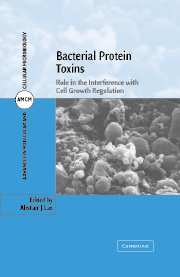Book contents
- Frontmatter
- Contents
- List of Contributors
- Preface
- 1 Toxins and the interaction between bacterium and host
- 2 The mitogenic Pasteurella multocida toxin and cellular signalling
- 3 Rho-activating toxins and growth regulation
- 4 Cytolethal distending toxins: A paradigm for bacterial cyclostatins
- 5 Bartonella signaling and endothelial cell proliferation
- 6 Type III–delivered toxins that target signalling pathways
- 7 Bacterial toxins and bone remodelling
- 8 Helicobacter pylori mechanisms for inducing epithelial cell proliferation
- 9 Bacteria and cancer
- 10 What is there still to learn about bacterial toxins?
- Index
- Plate section
- References
8 - Helicobacter pylori mechanisms for inducing epithelial cell proliferation
Published online by Cambridge University Press: 15 September 2009
- Frontmatter
- Contents
- List of Contributors
- Preface
- 1 Toxins and the interaction between bacterium and host
- 2 The mitogenic Pasteurella multocida toxin and cellular signalling
- 3 Rho-activating toxins and growth regulation
- 4 Cytolethal distending toxins: A paradigm for bacterial cyclostatins
- 5 Bartonella signaling and endothelial cell proliferation
- 6 Type III–delivered toxins that target signalling pathways
- 7 Bacterial toxins and bone remodelling
- 8 Helicobacter pylori mechanisms for inducing epithelial cell proliferation
- 9 Bacteria and cancer
- 10 What is there still to learn about bacterial toxins?
- Index
- Plate section
- References
Summary
Helicobacter pylori, the first bacterium to be designated a Class I carcinogen, has a major aetiological role in human gastric carcinogenesis. H. pylori infection is acquired primarily in childhood and, in the majority of instances, infection and associated chronic gastritis are lifelong. A key feature of H. pylori infection of relevance to the associated increased risk of developing gastric cancer is the hyperproliferation of gastric epithelial cells induced by the bacterium. Infection is associated with increased gastric epithelial cell proliferation in both humans and in experimental animal models.
Clinically, there is a marked diversity in the outcome of H. pylori infection and only a few infected subjects will develop gastric cancer (reviewed Peek and Blaser, 2002). Recent studies in Japan show that the risk of cancer with H. pylori infection is greatest in infected subjects with nonulcer dyspesia or gastric ulceration who develop severe gastric atrophy and intestinal metaplasia (Uemura et al., 2001). Bacterial virulence factors such as the cag pathogenicity island (PAI) (Blaser et al., 1995; Kuipers et al., 1995; Webb et al., 1999) and genetic polymorphisms in the interleukin-1β and IL-1 receptor antagonist genes associated with overexpression of IL-1 and hypochlorhydria (El-Omar et al., 2000; Machado et al., 2001; Furuta et al., 2002) have each been linked to an increased risk of developing gastric atrophy and/or intestinal type gastric cancer.
H. pylori is one of several chronic infections that have recently been associated with the development of neoplasia (see Chapter 9).
- Type
- Chapter
- Information
- Bacterial Protein ToxinsRole in the Interference with Cell Growth Regulation, pp. 169 - 198Publisher: Cambridge University PressPrint publication year: 2005
References
- 1
- Cited by

